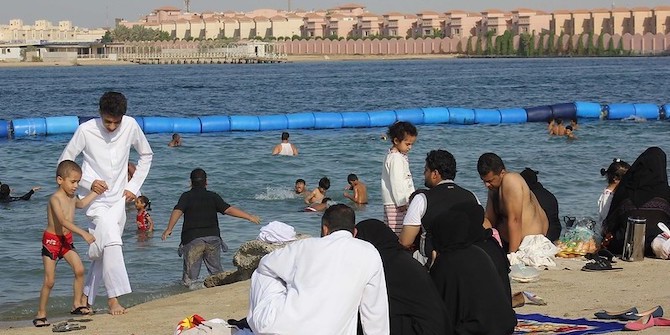by Sinem Cengiz
The Arab uprisings not only led to the emergence of a new regional order, but also transformed the internal dynamics of regional states, creating new alliances and rivalries in the politically fragile region. Amid geopolitical uncertainty, with shrinking US influence in the region, and declining oil prices, rival powers put forward their own projects for a new regional configuration and have since been willing to aggressively pursue the policies necessary to realise them.
Gönül Tol and David Dumke’s timely edited volume focuses on the triangular relationship between three key regional actors – Turkey, Saudi Arabia, and Egypt – which hold conflicting visions for the region, and the book also provides a good historical background to understand the contemporary era. The authors look at the domestic transformations these three countries have gone through in the last few years and how these dynamics influence their foreign policies. The book aims to provide, for both general readers and researchers of the region, a better understanding of the relationship between three regional states in an effort to gauge whether they can overcome their policy differences to play a constructive role in addressing regional problems. In doing so, the authors draw a nuanced and critical picture with empirically rich and relevant information in their respective countries of expertise.
In chapter one, Hakan Özoğlu presents a detailed and descriptive account of the diplomatic relations between the Ottoman Empire and early Turkish Republic, Egypt and Saudi Arabia in retrospect. In order to give the reader a better understanding of and appreciation for the dynamics shaping the complex relations between the three countries today, it is significant to look at the history. In doing so, Özoğlu utilises archival records and diplomatic notes. He concludes that the power struggle between these three aspiring regional leaders is nothing new and will continue to impact developments across the Middle East as it has before.
In chapter two, Meliha Altunışık delves into Turkey’s relations with Egypt and Saudi Arabia under the ruling Justice and Development Party (AKP); she argues that Ankara’s relations with Cairo and Riyadh have been significantly affected by their domestic transformations. The rise to power of President Abdel-Fattah el-Sisi in Egypt and Crown Prince Mohammed bin Salman in Saudi Arabia, with their policies and visions for the region that contradict the AKP’s, have led to a rivalry President Recep Tayyip Erdoğan’s Turkey. She points out that these Arab countries were initially tolerant of Turkey’s activism in the region, but the way Turkey is perceived in these capitals changed after the Arab uprisings. She elaborates upon the deterioration of Turkey’s relations with both Arab states through a realist reading of international relations.
In chapter three, Abderahman Salaheldin, who served as Egypt’s ambassador to Ankara between 2010–13 and was declared persona non-grata following increasing political tensions between Cairo and Ankara, focuses on how Egypt sees its role in the Middle East and its relations with the region’s two heavyweights. Salaheldin provides significant anecdotes from his personal experience during his tenure in Ankara and helps the reader to see the full picture beyond the secondary sources. The diplomat presents an Egyptian perspective on how Turkey’s policies are perceived in a region where Saudi Arabia and Egypt are also competing for influence.
In chapter four, David Dumke highlights the Saudis’ regional outlook and Riyadh’s relations with Egypt and Turkey from 1932 to 2001. From the establishment of the kingdom, he traces a thorough assessment of the highs and lows in Saudi Arabia’s relations with Turkey and Egypt during the eras of five Saudi kings. In the next chapter, Thomas Lippman elucidates the Saudi vision for the Middle East and how Turkey and Egypt fit into that. In the first part, he gives an up-to-date assessment of Saudi Arabia’s relations with Turkey through recent developments, such as the Qatar crisis of 2017 and the murder of the Saudi journalist Jamal Khashoggi at the Saudi consulate in Istanbul in early October 2018. In the second part, he focuses on the issues of convergence and difference between Saudi Arabia and Egypt under the leadership of President Sisi. Lippmann is reluctant to make predictions regarding future relations among Saudi Arabia, Egypt, and Turkey, arguing that ‘their complex relationship depends on developments and outcomes that are unknowable today: the durability of the Erdogan and Sisi regimes, the outcomes in Syria, the stability of Iraq, the nationalist ambitions of the Kurds, the evolution of Iran after the passing of Supreme Leader Ali Khamenei, the sustainability of the Qatar boycott.’
In chapter six, Robert Mogielnicki examines – through a political economy lens – whether political disputes between these countries have disrupted economic linkages between them. The analysis, which focuses primarily on the years between 2011 and 2018, concludes that deteriorating diplomatic and political relations have not profoundly affected their economic ties.
The book, a first attempt at understanding the general state of affairs between three key regional countries, concludes that the convergence between domestic developments and regional dynamics has been the main driving force of the relationship between the trio. While these factors have at times made cooperation easier, at other times they have driven a wedge between these countries, likely to continue for as long as each leadership remains in power.
Two minor potential shortfalls of the book stem from its lack of attention to the international factors that have played a role in shaping the relations between these three countries. An assessment of the positions and roles of world powers such as the US, Russia and China would enrich the study, given that domestic and regional drivers are widely elaborated upon. When all factors are considered, the relations between these countries is not only about rivalry between ambitious leaders, or competition between regional actors with different ideological backgrounds, but also a regional rivalry fuelled by the influence of global powers that have stakes in the region. Secondly, the authors could further develop their analysis by taking into account the role of other regional actors, most importantly non-Arab powers such as Israel and Iran, to present a better understanding of recent alliances in the region.







